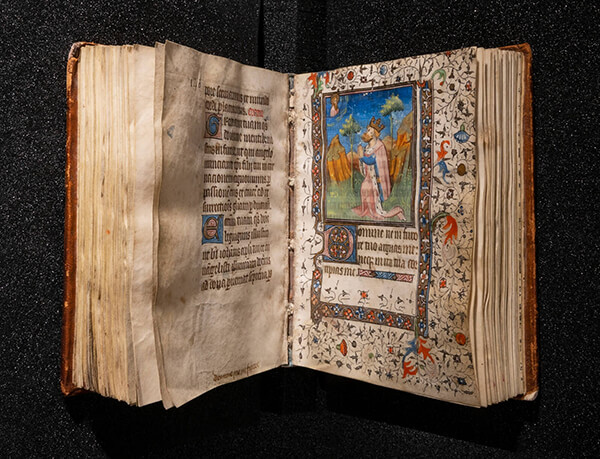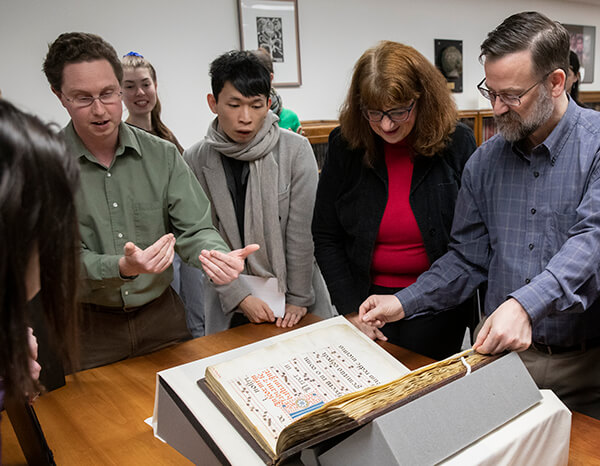
For most people, change isn’t synonymous with libraries but those who have the inside track know that change agents make the best librarians. The professional work involved in librarianship today includes identifying trends, learning and teaching new modalities, redefining best practices and maintaining relationships. It becomes clear in conversation with the Libraries’ newest faculty member, Special Collections Librarian Jeremy Dibbell, that he has what it takes.
When did you join Binghamton’s faculty?
My first day was Dec. 2, 2019, a day when we got about a foot of snow (so things got off to an auspicious start!). Looking back, it seems strange to think that I had only about three-and-a-half months in the library before we started working almost entirely remotely in mid-March, but my fingers are firmly crossed that we are through the worst of the COVID-19 pandemic here and we can continue to safely ease back into spending more time on campus during fall semester.
I joke about the snow, but actually having good winters was a plus for me when deciding to come back to upstate New York. I grew up in Chenango County, and having been away for a while, I was ready for snow again! Most recently, I was director of communications and outreach for Rare Book School based at the University of Virginia; prior to that, I was librarian for social media and rare books at LibraryThing, and an assistant reference librarian at the Massachusetts Historical Society.

Walk us through a day in the life of a Special Collections librarian.
One of the best things about Special Collections is that there really is no typical day. My colleagues and I all assist with class visits to look at materials from our collection (these are happening virtually at the moment, but we’re all looking forward to when we can welcome classes back into the reading room). We answer reference questions from around the world, plan and curate exhibitions of objects from our collections, and we generally work on finding ways to make the rare books, manuscripts and other materials at Binghamton more widely known to the University and local communities. We are also always on the lookout for additional material that we should acquire for our collections and are engaged in improving access to our collections by enhancing catalog records and archival finding guides. At the moment, we are all also learning a lot about providing remote access to our collections for researchers and class visits, so we’re doing a great deal of testing document cameras, filming equipment and lighting systems.
What group of materials are you most pleased to be working with here at Binghamton Libraries?
I’ve really enjoyed getting to know Binghamton’s Special Collections, which is full of fascinating things (it’s definitely hard to pick one!). I am very interested in the history of books and printing, so I was drawn to our collection of books from the library of publisher and antiquarian bookseller Herbert Reichner, but we also have a very cool collection of periodicals and journals relating to photography going back to the 1850s (many from the library of the Binghamton camera company Anitec) that are endlessly fascinating. I could go on. It’s easy to get excited about neat collections and, honestly, the more time I spend with books, the more interesting they get. There’s always more to learn!
If you could invest in any item or collection to add to our existing one, what would it be?
This may be even harder than trying to pick a favorite from among our current collections! I do have a perennial go-to answer for what I would buy if I had a few million dollars to spend: John James Audubon’s massive and exquisite Birds of America. His illustrations are incredibly striking, and there is so much to say about the history and publication of this book that it could keep me going for days. Hey, dream big, right?
More within the realm of possibility, I am always happy to add anything to the collection that works well for teaching, either because it complements things we already have or it shows something we couldn’t show before.
Are there any upcoming exhibits or projects that you would like to highlight?
One of the projects I’ve been working on while largely away from the library this spring and summer is a guide to specific examples from our collections that illustrate particular techniques of book production, bookbindings and illustrations, or that show ways books have been used over time by their readers. I’m looking forward to finishing that soon. I’ve also been finding books that have particularly interesting stories to tell about where they’ve been over the course of their lives, and am working on a series of posts for our blog about a few of those volumes.
This spring, we were planning to install an exhibition about farming and related industries in upstate New York (a subject near and dear to my heart, as my family has been farming in Chenango County since the 1830s). That has been postponed for the moment, but we look forward to sharing it when we can. It draws heavily on our excellent local history collections and on the local artifacts collected by Mark Kulikowski ’76, MA ’77, PhD ’82, and given to the Libraries before his death and through purchases we’ve made since then from an endowment established by his family.
Nationally, are there any trends in Special Collections that we should expect to see influence your work at Binghamton?
In the current situation, Special Collections librarians everywhere are facing the same difficulties we are. How can we continue to stress the importance of books and manuscripts as physical objects when it’s not safe to gather around as a group and look closely at them, which has been our model for several decades now? Coming up with fresh, innovative ways to effectively communicate the value of the artifact, and being able to provide efficient and suitable remote access for our students and researchers, is our top priority and goal, and we are deeply committed to making it work.






